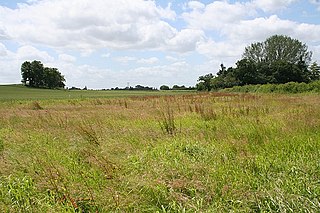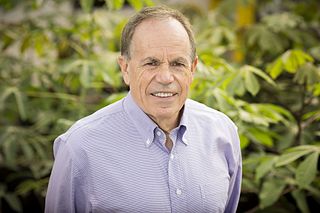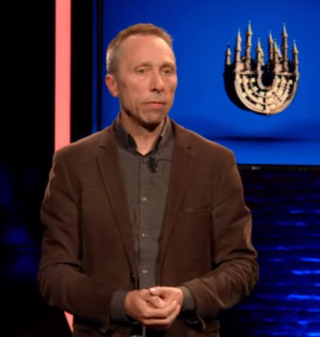
Panicum virgatum, commonly known as switchgrass, is a perennial warm season bunchgrass native to North America, where it occurs naturally from 55°N latitude in Canada southwards into the United States and Mexico. Switchgrass is one of the dominant species of the central North American tallgrass prairie and can be found in remnant prairies, in native grass pastures, and naturalized along roadsides. It is used primarily for soil conservation, forage production, game cover, as an ornamental grass, in phytoremediation projects, fiber, electricity, heat production, for biosequestration of atmospheric carbon dioxide, and more recently as a biomass crop for ethanol and butanol.

Corn stover consists of the leaves, stalks, and cobs of maize (corn) plants left in a field after harvest. Such stover makes up about half of the yield of a corn crop and is similar to straw from other cereal grasses; in Britain it is sometimes called corn straw. Corn stover is a very common agricultural product in areas of large amounts of corn production. As well as the non-grain part of harvested corn, the stover can also contain other weeds and grasses. Field corn and sweet corn, two different types of maize, have relatively similar corn stover.

Biomass, in the context of energy production, is matter from recently living organisms which is used for bioenergy production. Examples include wood, wood residues, energy crops, agricultural residues including straw, and organic waste from industry and households. Wood and wood residues is the largest biomass energy source today. Wood can be used as a fuel directly or processed into pellet fuel or other forms of fuels. Other plants can also be used as fuel, for instance maize, switchgrass, miscanthus and bamboo. The main waste feedstocks are wood waste, agricultural waste, municipal solid waste, and manufacturing waste. Upgrading raw biomass to higher grade fuels can be achieved by different methods, broadly classified as thermal, chemical, or biochemical.
The Energy Biosciences Institute (EBI) is an organization dedicated to developing new sources of energy and reducing the impact of energy consumption. It was created in 2007 to apply advanced knowledge of biology to the challenges of responsible, sustainable energy production and use. Its main goal is to develop next-generation biofuels—that is, biofuels that are made from the non-edible parts of plants and reduce greenhouse gas emissions.
Bioenergy with carbon capture and storage (BECCS) is the process of extracting bioenergy from biomass and capturing and storing the carbon, thereby removing it from the atmosphere. BECCS can be a "negative emissions technology" (NET). The carbon in the biomass comes from the greenhouse gas carbon dioxide (CO2) which is extracted from the atmosphere by the biomass when it grows. Energy ("bioenergy") is extracted in useful forms (electricity, heat, biofuels, etc.) as the biomass is utilized through combustion, fermentation, pyrolysis or other conversion methods.
Bioproducts or bio-based products are materials, chemicals and energy derived from renewable biological material.
Bioresource engineering is similar to biological engineering, except that it is based on biological and/or agricultural feedstocks. Bioresource engineering is more general and encompasses a wider range of technologies and various elements such as biomass, biological waste treatment, bioenergy, biotransformations, bioresource systems analysis, bioremediation and technologies associated with Thermochemical conversion technologies such as combustion, pyrolysis, gasification, catalysis, etc.
Biorefining is the process of "building" multiple products from biomass as a feedstock or raw material much like a petroleum refinery that is currently in use. A biorefinery is a facility like a petroleum refinery that comprises the various process steps or unit operations and related equipment to produce various bioproducts including fuels, power, materials and chemicals from biomass. Industrial biorefineries have been identified as the most promising route to the creation of a new domestic biobased industry producing entire spectrum of bioproducts or bio-based products.
Nasrin Moazami is an Iranian medical microbiologist and biotechnologist. She received her Ph.D. in 1976 from the Faculty of Medicine at Laval University. Moazami is the pioneer of biotechnology and microalgae-based fuels in Iran.
Bioproducts engineering or bioprocess engineering refers to engineering of bio-products from renewable bioresources. This pertains to the design and development of processes and technologies for the sustainable manufacture of bioproducts from renewable biological resources.
Johannes "Hans" van Leeuwen is educator, engineer, inventor, researcher, and entrepreneur. He is an emeritus professor of Civil, Construction and Environmental Engineering at Iowa State University and an entrepreneur in ethanol co-product development. His research and innovations have worked to solve various problems including, new water purification methods, a way of creating food and animal feed from waste, and a process in making the purest alcohol ever made.

The Great Lakes Bioenergy Research Center (GLBRC) is one of four bioenergy research centers established in 2007 by the U.S. Department of Energy. It is led by the University of Wisconsin-Madison with Michigan State University as a primary partner. The goal of GLBRC is to create biofuels and bioproducts that are economically viable and environmentally sustainable. GLBRC provides a collaborative environment in which researchers with diverse backgrounds are drawn together by their pursuit of scientific questions related to developing sustainable biofuels and bioproducts. GLBRC research focuses on engineering bioenergy crops to enhance their environmental and economic value, generating multiple products from plant biomass, and optimizing the field-to-product pipeline. Its research is integrated across many disciplines and areas of focus, coordinating efforts between academic, federal, and private sector bodies as part of the field-to-product pipeline.

Marginal land is land that is of little agricultural or developmental value because crops produced from the area would be worth less than any rent paid for access to the area. Although the term marginal is often used in a subjective sense for less-than-ideal lands, it is fundamentally an economic term that is defined by the local economic context. Thus what constitutes marginal land varies both with location and over time: for example, "a soil profile with a set of specific biophysical characteristics reported as “marginal” in the US corn belt may be one of the better soils available in another context". Changes in product values – such as the ethanol-demand induced spike in corn prices – can result in formerly marginal lands becoming profitable. Marginal lands can therefore be more difficult to delineate as compared to "abandoned crop lands" which reflect more clearly definable landowner-initiated land use changes.
Global Change Biology is a biweekly peer-reviewed scientific journal covering research on the interface between biological systems and all aspects of environmental change that affect a substantial part of the globe including climate change, global warming, land use change, invasive species, urbanization, wildfire, and greenhouse gases. The editor-in-chief is Stephen P. Long, environmental plant physiologist, Fellow of the Royal Society and member of the National Academy of Sciences.

Stephen Patrick Long is a British-born American environmental plant physiologist and member of the National Academy of Sciences studying how to improve photosynthesis to increase the yield of food and biofuel crops. He is the Stanley O. Ikenberry Chair Professor of Plant Biology and Crop Sciences at the University of Illinois and Distinguished Professor in Crop Sciences at Lancaster University. His work, published in Science, proved that photosynthesis can be manipulated to increase plant productivity—an idea once considered the holy grail of plant biology. Long has added to our understanding of the long-term impacts of climate change, such as rising levels of carbon dioxide and ozone on plants. He has briefed former President George W. Bush and the Vatican, as well as Bill Gates and Anne, Princess Royal, on food security and bioenergy.
Wendy Yang is an associate professor of Plant Biology and Geology at the University of Illinois Urbana-Champaign where she works on soil biogeochemistry and ecosystem ecology.

Donald Richard Ort is an American botanist and biochemist. He is the Robert Emerson Professor of Plant Biology and Crop Sciences at the University of Illinois at Urbana-Champaign where he works on improving crop productivity and resilience to climate change by redesigning photosynthesis. He is a member of the National Academy of Sciences (NAS) and a fellow of the American Association for the Advancement of Science (AAAS) and American Society of Plant Biologists (ASPB).

Bart Muys is a Belgian professor of forest ecology and forest management at the KU Leuven. His research focuses on the ecosystem functioning of tree diversity, the ecology of forest restoration and the evaluation of sustainability in forests and bioenergy systems. He is one of the most cited scientists internationally in the field of silviculture and forest management.
Jennifer Pett-Ridge is an American biologist who is a senior staff scientist at the Lawrence Livermore National Laboratory. She also serves as an adjunct professor at the University of California, Merced. Her research makes use of systems biology and geochemistry to uncover function in microbial communities. She was awarded a 2021 United States Department of Energy Ernest Orlando Lawrence Award.
Biomass is a term used in several contexts: in the context of ecology it means living organisms, and in the context of bioenergy it means matter from recently living organisms. In the latter context, there are variations in how biomass is defined, e.g. only from plants, or from plants and algae, or from plants and animals. The vast majority of biomass used for bioenergy does come from plants. Bioenergy is a type of renewable energy with potential to assist with climate change mitigation.







